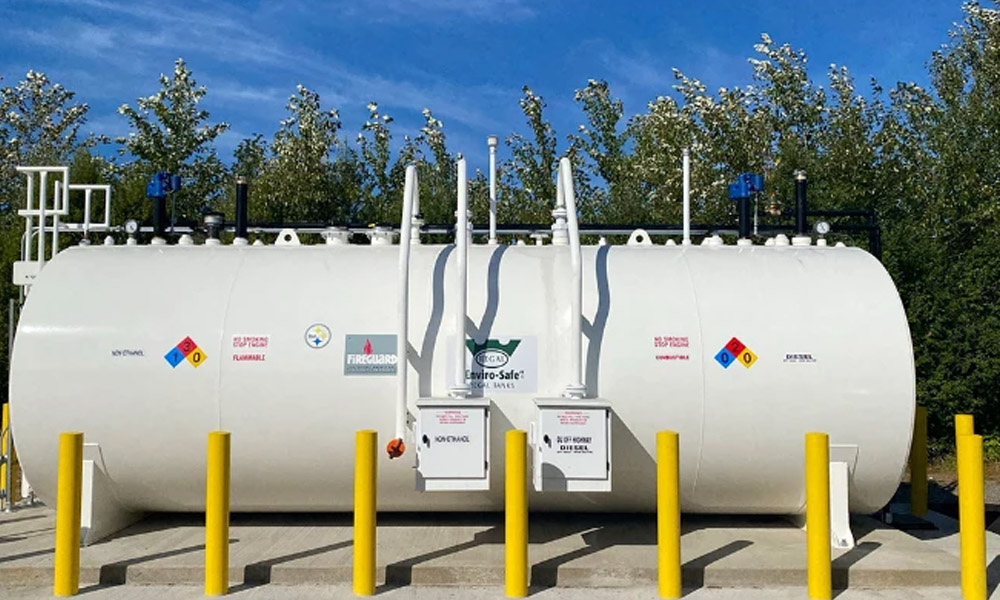Business
Sturdy and Secure: Unlocking Above Ground Fuel Tank Benefits
Published
2 days agoon
By
Admin
What Are Above Ground Fuel Tanks?
Above ground fuel tanks are durable containers designed to store fuels like gasoline, diesel, or heating oil at ground level, offering a reliable solution for residential, commercial, and industrial applications. These tanks, typically constructed from steel, fiberglass, or polyethylene, range from small 275-gallon units for home heating to large industrial models holding tens of thousands of gallons. Unlike underground tanks, above ground fuel tanks are valued for their accessibility, ease of maintenance, and reduced environmental risks. Their visibility simplifies inspections, making them a popular choice for gas stations, farms, and manufacturing facilities where secure fuel storage is essential.
Key Benefits of Above Ground Fuel Tanks
Above ground fuel tanks provide numerous advantages over underground systems. Their placement at ground level allows for quick visual inspections, enabling early detection of leaks, corrosion, or structural issues. Installation is less invasive, requiring minimal excavation, which lowers costs and environmental disruption. Maintenance is straightforward, as technicians can easily access the tank for cleaning or repairs. These tanks are also portable, offering flexibility for relocation if needs change. Environmentally, above ground fuel tanks reduce the risk of undetected leaks seeping into soil or groundwater, a common issue with underground tanks. Features like double-walled designs and spill containment systems further enhance safety, making them a dependable choice for eco-conscious fuel storage.
Design and Material Options
Above ground fuel tanks come in various designs to suit diverse applications. Single-walled tanks are cost-effective for low-risk uses, such as storing heating oil, while double-walled tanks offer an additional layer of leak protection for flammable fuels like gasoline or diesel. Steel tanks are prized for their durability in heavy-duty industrial settings, while fiberglass or polyethylene tanks resist corrosion, making them ideal for humid or coastal environments. Additional features, such as overfill alarms, anti-siphon valves, and secondary containment trays, improve functionality and compliance. Tanks can be customized in size and shape—cylindrical for fuel or rectangular for compact spaces—ensuring versatility for different needs.
Applications Across Sectors
Above ground fuel tanks serve a wide range of industries due to their adaptability. In agriculture, they store diesel for tractors and irrigation pumps, ensuring reliable access to fuel. Gas stations use them for gasoline and diesel storage, benefiting from easy refilling and maintenance. Industrial facilities rely on them for lubricants or backup fuel supplies, while residential users opt for compact tanks for heating oil. Their scalability makes them suitable for both small operations and large complexes. As environmental regulations tighten, above ground fuel tanks are increasingly favored for their low ecological impact and ease of compliance.
Maintenance for Long-Term Performance
Maintaining above ground fuel tanks is essential to ensure durability and safety. Regular inspections, typically conducted annually, check for rust, loose fittings, or sediment buildup that could clog fuel lines. Periodic cleaning removes sludge, maintaining tank capacity and fuel quality. Keeping the tank area clear of debris and ensuring proper drainage prevents water accumulation, which can accelerate corrosion. Advanced monitoring systems, such as leak detection sensors, provide real-time alerts for potential issues. With proper care, above ground fuel tanks can last 20 to 30 years, offering reliable performance and minimizing the need for costly repairs or replacements.
Cost and Longevity Considerations
The cost of above ground fuel tanks depends on size, material, and features. Small residential tanks range from $1,500 to $3,000, while large industrial models can exceed $50,000. Installation costs are lower than for underground tanks due to minimal excavation. Maintenance expenses, such as cleaning and inspections, are also reduced thanks to easy access. With proper maintenance, these tanks offer excellent longevity, often lasting decades. Their durability, combined with reduced environmental risks and regulatory compliance, makes above ground fuel tanks a cost-effective solution for long-term fuel storage.
Environmental and Safety Features
Environmental protection is a key strength of above ground fuel tanks. Their above-ground placement makes leaks immediately visible, allowing rapid response to prevent soil or water contamination. Double-walled tanks include a secondary containment layer to capture leaks, while spill containment trays collect accidental overflows, reducing environmental risks. Compliance with Environmental Protection Agency (EPA) regulations and local fire codes ensures safe operation, particularly for flammable fuels. Regular monitoring, including visual inspections and pressure testing, minimizes the chance of spills, protecting local ecosystems and water sources. These features make above ground fuel tanks a sustainable option for secure fuel management.
Regulatory Compliance and Best Practices
Compliance with regulations is critical for above ground fuel tanks. The EPA and local authorities set standards for tank placement, spill prevention, and maintenance to minimize fire and environmental risks. Tanks storing flammable fuels must include secondary containment, overfill protection, and proper venting systems. Regular inspections ensure compliance and identify issues like corrosion or leaks before they escalate. Best practices include maintaining detailed maintenance records, scheduling periodic cleanings, and using corrosion-resistant materials in challenging climates. Adhering to these standards avoids fines, which can reach tens of thousands of dollars, and ensures safe operation.
Planning for Optimal Use
Effective planning maximizes the benefits of above ground fuel tanks. A site assessment evaluates soil stability, drainage, and proximity to sensitive areas like water sources. Consulting with local authorities secures necessary permits and ensures compliance with zoning laws. Choosing the right tank size and material based on fuel type and usage needs ensures optimal performance. Partnering with experienced contractors for installation and maintenance guarantees quality and adherence to regulations. Detailed planning minimizes disruptions and ensures the tank meets operational and environmental goals.
Emerging Trends in Fuel Tank Technology
Advancements in technology are enhancing above ground fuel tanks. Smart sensors for real-time monitoring of fuel levels, leaks, and corrosion enable predictive maintenance, reducing downtime and costs. Innovations in materials, such as advanced composites, improve durability and resistance to environmental factors. Eco-friendly designs, like integrated spill containment and recyclable components, align with growing sustainability demands. These advancements make above ground fuel tanks more efficient, safer, and environmentally responsible, ensuring they remain a top choice for fuel storage across industries.
The Value of Above Ground Fuel Tanks
Above ground fuel tanks offer a powerful combination of safety, accessibility, and environmental benefits. Their ease of installation, maintenance, and compliance reduces operational costs and risks compared to underground systems. The visibility and robust design features ensure quick issue detection, protecting both the environment and budgets. As industries and homeowners prioritize efficiency and sustainability, above ground fuel tanks stand out as a reliable, forward-thinking solution for secure fuel storage, delivering lasting value and peace of mind for decades.

Aruba Adventures: Best Beaches, Snorkeling & Things to Do

Essentials Hoodie Perfect for Everyday Streetwear

Denim Tears Threads of Memory and Modern Resistance

How Kendrick Lamar’s Sister, Kayla Duckworth, Built Her Own Success

Meet Julian Henry De Niro: The Smart and Talented Son of Robert De Niro

The Benefits Of Submersible Dredge Pumps In Large Projects

E-Learning Mobile App Development Company: Transforming the Future of Education

Cameron Friscia: The Story of Kat Timpf’s Husband, From Military to Marriage

Are You a Candidate for Cataract Surgery London? Signs You Need to See a Specialist

Back to School 2025: What Teachers Really Need on Their Supply Lists

Curious About JOI Database? Read This First Before You Click Anything

Jacqueline Bernice Mitchell: The Inspiring Story of Jerry Rice’s Ex-Wife

Should You Use Wooflix in 2025? Honest Review and Best Alternatives

Where Is Noelle Watters Now? Jesse Watters’ Ex-Wife’s Life After Divorce

Who Is Marlene Knaus? The Untold Story of Niki Lauda’s First Wife

ECMISS: The Intelligent System Behind Smarter Everything

Alisande Ullman Today: What Happened After Her Divorce from Leslie Nielsen?

Where Is Tanya Hijazi Now?: All About Rick James’ Former Wife

What Happened to Frances Cain After Her Split from Jeremy Clarkson?

Where Is Anne Steves Now? The Truth About Rick Steves’ Ex-Wife

Aruba Adventures: Best Beaches, Snorkeling & Things to Do

Essentials Hoodie Perfect for Everyday Streetwear

Denim Tears Threads of Memory and Modern Resistance

How Kendrick Lamar’s Sister, Kayla Duckworth, Built Her Own Success

Meet Julian Henry De Niro: The Smart and Talented Son of Robert De Niro

The Benefits Of Submersible Dredge Pumps In Large Projects

E-Learning Mobile App Development Company: Transforming the Future of Education

Cameron Friscia: The Story of Kat Timpf’s Husband, From Military to Marriage

Are You a Candidate for Cataract Surgery London? Signs You Need to See a Specialist

Back to School 2025: What Teachers Really Need on Their Supply Lists
Categories
Trending
-

 Entertainment4 months ago
Entertainment4 months agoCurious About JOI Database? Read This First Before You Click Anything
-

 Celebrity2 months ago
Celebrity2 months agoJacqueline Bernice Mitchell: The Inspiring Story of Jerry Rice’s Ex-Wife
-

 Entertainment4 months ago
Entertainment4 months agoShould You Use Wooflix in 2025? Honest Review and Best Alternatives
-

 Celebrity2 months ago
Celebrity2 months agoWhere Is Noelle Watters Now? Jesse Watters’ Ex-Wife’s Life After Divorce
